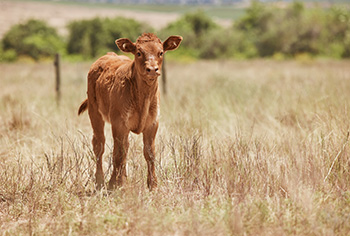Herd Health in Weaned Calves
Dr. Cathy Barnette, a paid Consultant for Covetrus®
Transitioning weaned calves from a cow-calf operation to a feedlot or production herd comes with numerous challenges. The weeks immediately after weaning are associated with significant health risks, impacting both survival and weight gain. In addition to the stress of weaning, calves are often transported at this time; as they are recovering from these stressors, they must also acclimate to a new environment, a new diet, and a new social group that are very different from the farm or pasture on which they were raised. Traditionally, many cattle producers have adopted a do-it-yourself mentality towards this stage of production. This is especially true for small-scale producers, but can also be seen even in larger operations. An ongoing, collaborative relationship with a veterinarian, however, can offer a wide variety of benefits for producers. Not only will an established veterinarian-client patient-relationship (VCPR) allow problems and illnesses to be addressed efficiently, veterinarians are in a unique position to work collaboratively with producers, improving both their herd health and financial bottom line.
While producers often think of vaccination and parasite control as the primary drivers of herd health, veterinarians can offer their expertise on many other aspects of herd health, leading to greater weight gain and profitability. Think beyond vaccines and parasite control and emphasize the following aspects of herd health with your clients.

Processing
After traveling from a cow-calf operation to join a production herd, the newly weaned calves must be processed. Processing typically involves administering vaccines (if not administered prior to transport), inserting implants (if applicable), and branding (if applicable). Additionally, all cattle should be weighed and sorted into similar groups for housing purposes. While producers may be tempted to start processing new arrivals immediately, recommend a 24-hour rest period.1 During this time, cattle should be given free access to hay and fresh water. This rest period will provide an opportunity for rest and rehydration. Work with producers to develop a rational plan for processing. Evaluate which services can and should be performed, and work with producers to ensure that they are conducting their processing in a low-stress manner. Minimizing stress associated with processing can decrease the likelihood of illness and contribute to increased weight gain.
Weaning
Weaning shock is a well-documented phenomenon in calves transitioning from milk to a young stock diet. Calves often lose weight during this period, due to physiological and psychological stresses associated with weaning. However, there are less-visible internal changes that occur during this time. In Holstein calves, for example, weaning has been associated with an increase in cortisol, acute-phase proteins, inflammatory cytokines, and some types of leukocytes.2 These immune changes can lead to an increased risk of illness, and should be managed appropriately. Producers can take a number of steps to decrease weaning shock. Ideally, calves should be gradually separated from their dams over time, instead of taking an abrupt approach. Two stage weaning can be accomplished using fence lines or nose-flaps that prevent suckling.3 Taking a gradual approach to weaning can decrease stress associated with this transition.
Nutrition
Producers can mitigate the effects of weaning shock by providing supplemental nutrition in the days preceding and following weaning.4 In most cases, calves are accustomed to eating grass with their dam. Feeding high-quality hay for several days can help calves transition to the production setting. After a few days, producers should begin adding supplemental protein and energy to the diet, in the form of a total mixed ration or top-dressing added to hay.4 While these general strategies can be beneficial, specific considerations vary based on season, available feedstuffs, and other factors. By working closely with producers, you can help them develop the best possible nutrition program for their unique circumstances, ensuring that the herd gains weight rapidly and efficiently.
Although producers may often take a do-it-yourself approach to herd health, a veterinarian can add value in many ways. Work with producers to think outside the box, considering strategies beyond just vaccination and parasite control when developing a herd health program. In addition to streamlining processing, mitigating the effects of weaning shock, and promoting optimal nutrition, you can aid producers in developing plans to address biosecurity, recordkeeping, animal welfare, and a variety of other factors. Working closely with a veterinarian will allow producers to reap financial rewards associated with reduced morbidity, reduced mortality, and increased weight gain.
About the author Cathy Barnette, DVM is a veterinarian and freelance writer, based in Southwest Florida. After graduating from the University of Florida in 2006, Dr. Barnette spent 14 years working in small animal general practice. Her current professional focus is veterinary writing, creating educational content for veterinary teams and their clients. Dr. Barnette is a paid Consultant for Covetrus®.
- Felix, T. (2023). Transitioning Calves: From Pasture to Feedlot. PennState Extension. Retrieved from: https://extension.psu.edu/transitioning-calves-from-pasture-to-feedlot
- Kim, M. H., Yang, J. Y., Upadhaya, S. D., Lee, H. J., Yun, C. H., & Ha, J. K. (2011). The stress of weaning influences serum levels of acute-phase proteins, iron-binding proteins, inflammatory cytokines, cortisol, and leukocyte subsets in Holstein calves. Journal of veterinary science, 12(2), 151–157. Retrieved from: https://www.ncbi.nlm.nih.gov/pmc/articles/PMC3104169/
- Felix, T. (2023). Reducing Stress at Weaning. PennState Extension. Retrieved from: https://extension.psu.edu/reducing-stress-at-weaning
- Wilke, K., Clark, H. (2022). Management , Health, and Nutritional Considerations for Weaning Calves. Nebraska Extension. Retrieved from: https://extensionpublications.unl.edu/assets/html/g2057/build/g2057.htm
Careers
Are you looking for a place to let your talents shine? At Covetrus, we help our practitioner customers better serve their patients and take pride in providing the best customer experience possible. Search our open positions to see our available opportunities.
Newsletter
Stay current with what’s going on with Covetrus, subscribe to receive our newsletter and email communications. Subscribers will receive the latest information in practice management, sales and marketing, animal health, and more.


Leave a comment